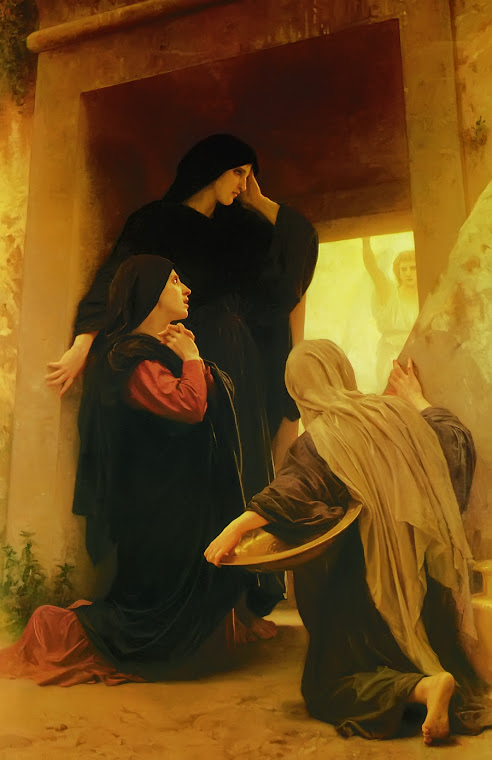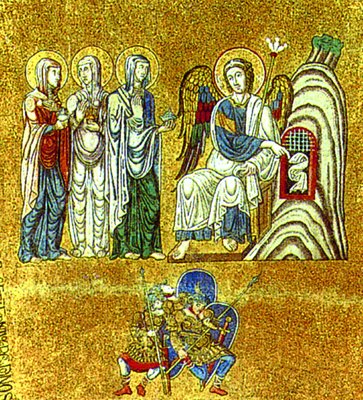1. The first day of the week comes Mary Magdalene early, when it was yet dark, to the sepulcher, and sees the stone taken away from the sepulcher.
2. Then she runs, and comes to Simon Peter, and to the other disciple, whom Jesus loved, and says to them, They have taken away the Lord out of the sepulcher, and we know not where they have laid him.
3. Peter therefore went forth, and that other disciple, and came to the sepulcher.
4. So they ran both together: and the other disciple did outrun Peter, and came first to the sepulcher.
5. And he stooping down, and looking in, saw the linen clothes lying: yet went he not in.
6. Then comes Simon Peter following him, and went into the sepulcher, and seeing the linen clothes lie,
7. And the napkin, that was about his head, not lying with the linen clothes, but wrapped together in a place by itself:
8. Then went in also that other disciple, which came first to the sepulcher, and he saw, and believed.
9. For as yet they knew not the Scripture, that he must rise again from the dead.
CHRYS. The Sabbath being now over, during which it was unlawful to be there, Mary Magdalene could rest no longer, but came very early in the morning, to seek consolation at the grave: The first day of the week comes Mary Magdalene early, when it was yet dark, to the sepulcher.
AUG. Mary Magdalene, undoubtedly the most fervent in love, of all the women that ministered to our Lord; so that John deservedly mentions her only, and says nothing of the others who were with her, as we know from the other Evangelists.
AUG. Una sabbati is the day which Christians call the Lord's day, after our Lord's resurrection. Matthew calls it prima sabbati.
BEDE. Una sabbati, i.e. one day after the sabbath.
THEOPHYL. Or thus: The Jews called the days of the week sabbath, and the first day, one of the sabbaths, which day is a type of the life to come; for that life will be one day not cut short by any night, since God is the sun there, a sun which never sets. On this day then our Lord rose again, with an incorruptible body, even as we in the life to come shall put on incorruption.
AUG. What Mark says, Very early in the morning, at the rising of the sun, does not contradict John's words, when it was yet dark. At the dawn of day, there are yet remains of darkness, which disappear as the light breaks in. We must not understand Mark's words, Very early in the morning, at the rising of the sun, to mean that the sun was above the horizon, but rather what we ourselves ordinarily mean by the phrase, when we want any thing to be done very early, we say at the rising of the sun, i.e. some time before the sun is risen.
GREG. It is well said, When it was yet dark: Mary was seeking the Creator of all things in the tomb, and because she found Him not, thought He was stolen. Truly it was yet dark when she came to the sepulcher.
And sees the stone taken away from the sepulcher.
AUG. Now took place what Matthew only relates, the earthquake, and rolling away of the stone, and fight of the guards.
CHRYS. Our Lord rose while the stone and seal were still on the sepulcher. But as it was necessary that others should be certified of this, the sepulcher is opened after the resurrection, and so the fact confirmed. This it was which roused Mary. For when she saw the stone taken away, she entered not nor looked in, but ran to the disciples with all the speed of love. But as yet she knew nothing for certain about the resurrection, but thought that His body had been carried off.
GLOSS. And therefore she ran to tell the disciples, that they might seek Him with her, or grieve with her: Then she runs, and comes to Simon Peter, and to the other disciple, whom Jesus loved.
AUG. This is the way in which he usually mentions himself. Jesus loved all, but him in an especial and familiar way. And says to them, They have taken away the Lord out of the sepulcher, and we know not where they have laid Him.
GREG. She puts the part for the whole; she had come only to seek for the body of our Lord, and now she laments that our Lord, the whole of Him, is taken away.
AUG. Some of the Greek copies have, taken away my Lord, which is more expressive of love, and of the feeling of an handmaiden. But only a few have this reading.
CHRYS. The Evangelist does not deprive the woman of this praise, nor leaves out from shame, that they had the news first from her. As soon as they hear it, they hasten to the sepulcher.
GREG. But Peter and John before the others, for they loved most; Peter therefore went forth, and that other disciple, and came to the sepulcher.
THEOPHYL. But how came they to the sepulcher, while the soldiers were guarding it? an easy question to answer. After our Lord's resurrection and the earthquake, and the appearance of the angel at the sepulcher, the guards withdrew, and told the Pharisees what had happened.
AUG. After saying, came to the sepulcher he goes back and tells us how they came: So they ran both together: and the other disciple did outrun Peter, and came first to the sepulcher; meaning himself, but he always speaks of himself, as if he were speaking of another person.
CHRYS. On coming he sees the linen clothes set aside: And he stooping down, and looking in, saw the linen clothes lying. But he makes no further search: yet went he not in.
Peter on the other hand, being of a more fervid temper, pursued the search, and examined every thing: Then comes Simon Peter following him, and went into the sepulcher, and sees the linen clothes lie, and the napkin, that was about His head, not lying with the linen clothes, but wrapped together in a place by itself. Which circumstances were proof of His resurrection. For had they carried Him away, they would not have stripped Him; nor, if any had stolen Him, would they have taken the trouble to wrap up the napkin, and put it in a place by itself, apart from the linen clothes; but would have taken away the body as it was. John mentioned the myrrh first of all, for this reason, i.e. to show you that He could not have been stolen away. For myrrh would make the linen adhere to the body, and so caused trouble to the thieves, and they would never have been so senseless as to have taken this unnecessary pains about the matter.
After Peter however, John entered: Then went in also that other disciple, which came first to the sepulcher, and he saw, and believed.
AUG. i.e. That Jesus had risen again, some think: Ah, but what follows contradicts this notion. He saw the sepulcher empty, and believed what the woman had said: For as yet they knew not the Scripture, that He must rise again from the dead. If he did not yet know that He must rise again from the dead, he could not believe that He had risen. They had heard as much indeed from our Lord, and very openly, but they were so accustomed to hear parables from Him, that they tool; this for a parable, and thought He meant something else.
GREG. But this account of the Evangelist must not be thought to be without some mystical meaning. By John, the younger of the two, the synagogue; by Peter, the elder, the Gentile Church is represented: for as though the synagogue was before the Gentile Church as regards the worship of God, as regards time the Gentile world was before the synagogue. They ran together, because the Gentile world ran side by side with the synagogue from first to last, in respect of purity and community of life, though a purity and community of understanding they had not.
The synagogue came first to the sepulcher, but entered not: it knew the commandments of the law, and had heard the prophecies of our Lord's incarnation and death, but would not believe in Him who died. Then comes Simon Peter, and entered into the sepulcher: the Gentile Church both knew Jesus Christ as dead man, and believed in Him as living God. The napkin about our Lord's head is not found with the linen clothes, i.e. God, the Head of Christ, and the incomprehensible mysteries of the Godhead are removed from our poor knowledge; His power transcends the nature of the creature. And it is found not only apart, but also wrapped together; because of the linen wrapped together, neither beginning nor end is seen; and the height of the Divine nature had neither beginning nor end. And it is into one place: for where there is division, God is not; and they merit His grace, who do not occasion scandal by dividing themselves into sects.
But as a napkin is what is used in laboring to wipe the sweat of the brow, by the napkin here we may understand the labor of God: which napkin is found apart, because the suffering of our Redeemer is far removed from ours; inasmuch as He suffered innocently, that which we suffer justly; He submitted Himself to death voluntarily, we by necessity. But after Peter entered, John entered too; for at the end of the world even Judea shall be gathered in to the true faith.
THEOPHYL. Or thus: Peter is practical and prompt, John contemplative and intelligent, and learned in divine things. Now the contemplative man is generally beforehand in knowledge and intelligence, but the practical by his fervor and activity gets the advance of the other's perception, and sees first into the divine mystery.
Catena Aurea John 20






